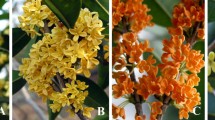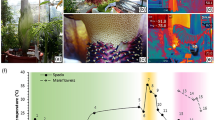Abstract
This research was initiated to analyze the volatiles emitted from a single flower bud of Lilium longiflorum Thunb., L. callosum Sieb. et Zucc., and their interspecific hybrids L. longiflorum × L. callosum (L. longi × L. cal IH). Volatiles, collected automatically every 6-hour intervals at 20°C before anthesis and at anthesis, were analyzed using a coupled gas chromatography-mass spectrometer. The most abundant volatiles in L. longiflorum occurred at retention time (rt) 12.17 (peak 7) and rt 6.87 min (peak 3), and were tentatively identified as 1,6,10-dodecatrien-3-ol (nerolidol) and 3,7-dimethyl-1,3,7-octariene (ocimene), respectively, and sensory evaluation assessed the blend to have a pleasant fragrance. However, these peaks were not observed in L. callosum which produced a relatively low level of volatiles at rt 5.36, rt 5.84, and rt 12.31 min. Emission of volatiles from a single flower bud showed a diurnal rhythm peaking between 2000 and 0200 HR and also at anthesis. The level of volatiles released from L. longi × L. cal IH flowers was less than that from L. longiflorum, and no odor was evident by sensory evaluation. Mild and pleasant fragrance of L. longi × L. cal IH results from the inheritance of volatiles such as ocimene and nerolidol from L. longiflorum at a reduced level and the lack of production of volatiles that could produce odors.
Similar content being viewed by others
Literature Cited
Altenburger, R. and P. Matile. 1990. Further observations on rhythmic emission of fragrance in flowers. Planta 180:194–197.
Christensen, S.A., A. Nemchenko, E. Borrego, I. Murray, I.S. Sobhy, L. Bosak, S. DeBlasio, M. Erb., C.A.M. Rogert, K.A. Vaughan, C. Herrfurth, J. Tumlinson, I. Feussaner, D. Jackson, T.C.J. Turlings, J. Engelberth, C. Nansen, R. Meeley, and M.V. Kolmiets. 2013. The maize lipoxygenase, ZmLOX10, mediates green leaf volatile, jasmonate and herbivore-induced plant volatile production for defense against insect attack. Plant J. 74:59–73.
Dickens, J.C., J.E. Oliver, B. Hollister, J.C. Davis, and J.A. Klun. 2002. Breaking a paradigm: Male-produced aggregation pheromone for the Colorado potato beetle. J. Exp. Biol. 205:1925–2002.
Fukai, S. and T. Kawasaki. 2005. Measurement of lily fragrance by use of handy e-nose. Aroma Res. 24:61–67 (In Japanese with English abstract).
Garner, C.E., S. Smith, B. de Lacy Costello, P. White, R. Spencer, C.S. Probert, and N.M. Ratcliffe. 2007. Volatile organic compounds from feces and their potential for gastrointestinal disease diagnoses. The FASEB J. 21:1675–1688.
Matile, P. and R. Altenburger. 1988. Rhythms of fragrance emission in flowers. Planta 174:242–247.
Oyama-Okubo, N., M. Nakayama, and K. Ichimura. 2011. Control of floral scent emission by inhibitors of phenylalanine ammonia-lyase in cut Flower of Lilium cv. ‘Casa Blanca’. J. Japan. Soc. Hort. Sci. 80:190–199.
Roh, M.S., R.J. Griesbach, and R.H. Lawson. 1996a. Evaluation of interspecific hybrids of Lilium longiflorum and L. × elegans. Acta Hort. 414:101–110.
Roh, M.S., R.J. Griesbach, K.C. Gross, and M. Line. 1996b. Identification and evaluation of the interspecific hybrid between Lilium longiflorum and L. callosum. Acta Hort. 414:111–124.
Roh, S.M., D.Y. Yeam, and Y.J. Kim. 1978. Native bulb materials in the wild and their production for cultivation as a floricultural crop. I. Survey and bulb production. J. Kor. Soc. Hort. Sci. 19: 129–146 (in Korean with English abstract).
Roh, S.M., D.Y. Yeam, and Y.J. Kim. 1979. Native bulb materials in the wild and their production for cultivation as a floricultural crop. II. Forcing experiment. J. Kor. Soc. Hort. Sci. 20:84–93 (in Korean with English abstract).
Sohn, K., J.-S. Song, Y.A. Chae, and K.S. Kim. 1998. The growth and analysis of essential oil of Elsholtzia splendens Nakai. J. Kor. Soc. Hort. Sci. 40:271–275.
Suh, J.K., A.K. Lee, M.S. Roh, J.S. Lee, J.-S. Lee, and Y.H. Joung. 2013a. Relationships of Lilium species native to Korea analyzed by internal transcribed spacers of rRNA genes. Acta Hort. 559–565.
Suh, J.K., X.W. Xu, A.K. Lee, and M.S. Roh. 2013b. Growth and flowering physiology, and developing new technologies to increase the flower numbers in the Genus Lilium. Hort. Environ. Biotechnol. 54:373–387.
Teai, T., J.-P. Bianchini, and A. Claude-Lafontaine. 1998. Volatile constituents of the flower buds concrete of Premna serratifolia L. J. Essential Oil Res. 10:307–309.
Author information
Authors and Affiliations
Corresponding author
Rights and permissions
About this article
Cite this article
Kim, J.H., Roh, M.S., Dickens, J.C. et al. Volatiles emitted from single flower buds of a Lilium longiflorum × L. callosum interspecific hybrid and its parents. Hortic. Environ. Biotechnol. 55, 410–414 (2014). https://doi.org/10.1007/s13580-014-0047-0
Received:
Revised:
Accepted:
Published:
Issue Date:
DOI: https://doi.org/10.1007/s13580-014-0047-0




